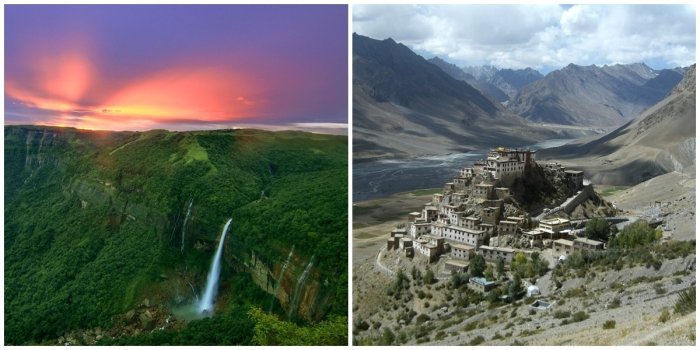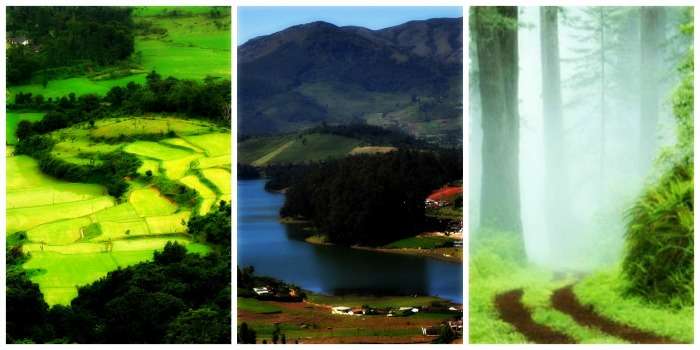Advertisement
When nature and the human mind work harmoniously, unforgettable memories are created. And if thoughts of lush fields, towering trees, rushing rivers, sun-drenched backdrops, and undulating hills spring to mind, then you'll want to check out our comprehensive list of the Best Nature Places in India, where you'll be able to bask in the rays, dive into the waves, and take in the fresh air. Let your inner environmentalist out! Explore the unfathomable wonders of India's geography, where the wilds hide the solutions to problems that humanity hasn't ever thought to ask.
Frozen River Hike

The Chadar Trip in Ladakh is a trek across the frozen river of Zanskar that links the settlements in the Zanskar valley with Chilling, and it is the most unusual type of trekking one may go in India (on the road to Leh). This journey is safest and most advisable in February when the ice is at its steadiest.
Destination: Loktak Lake, Manipur
Loktak Lake in Manipur is one of the biggest lakes in northeastern India and is a must-see for peace-seekers. Manipur, where it is situated, is widely regarded as having some of India's finest scenery. Since it is the only floating lake in the world, a trip to Loktak Lake is one of a kind for ecotourists. The floating Phumdis in this lake, India's biggest freshwater body, paint a beautiful image of the lake's natural bounty and diversity.
Magnetic Hill in Leh, India
Thanks to the hill's powerful magnetic pull, vehicles always seem to end up on top of it. Its magnetic pull can cause transmission problems for nearby planes, even at a safe distance.
Rat Temple In Rajasthan.
Karni Mata Temple, sometimes known as the "rat temple," is situated near Deshnoke, Rajasthan, around 30 kilometers from Bikaner. The temple is home to over 20,000 rats, which are seen as lucky in Hinduism. It is claimed that the goddess Karni Mata, who has her temple here, performed multiple miracles in the 14th century. People from all walks of life, including believers who think presenting a gift to the rats here, would bring them luck, and curious onlookers, go to this temple.
The Shores of Sikkim's Gurudongmar Lake
The Gurudongmar Lake in Sikkim is well-known for its picturesque setting among snow-capped mountains and glaciers and for the healing effects of its cold, clear water. This magnificent lake, named after the founder of Tibetan Buddhism, Guru Rinpoche, is revered by Buddhists, Sikhs, and Hindus. Gurudongmar Lake is one of Sikkim's unspoiled, lesser-known attractions, and a trip there combines sightseeing, spirituality, and physical challenge. Learn the mysterious history of this holy lake, located at an impressive 5425 m in elevation not far from the Tibetan border.
Shimla
The town's unique neo-gothic architecture, deep forests, and breathtaking vistas are all remnants of its colorful colonial history and make it seem highly distinct from the rest of India. 'The Mall' is the city's primary commercial thoroughfare and a popular gathering place for visitors and permanent residents. There are also several exciting nightlife options for people who want to increase the volume in this neighborhood. The Christ Church is the second oldest church in northern India and features stained glass windows constructed uniquely. Stay in Shimla before climbing Jakhu Hill, the tallest peak and a popular hangout for the city's numerous playful monkeys, who wait patiently to be fed by visitors. Chai, a rather off-the-beaten-path location, is also accessible from Shimla.
The Uttarakhand Valley Of Flowers

If you're a nature lover who appreciates vivid hues, this valley in India should be on your itinerary. Trekkers and photographers go there because of the abundance of uncommon and exotic Himalayan flora. There is excellent cause for this national park to be included as a UNESCO World Heritage Site.
Nubra Valley, Ladakh
Located between Tibet as well as Kashmir, the Nubra valley is famous for its orchards, Bactrian camels, picturesque panoramas, and monasteries. At Turtuk, you may learn about a new culture (the Balti) and see dunes, monasteries, and a ruined palace. The valley is one of India's most beautiful sites, with a gorgeous and spectacular vista.
The Nanda Devi Himalayas In Uttarakhand
Nanda Devi, the world's second-highest mountain, is located within the stunning Nanda Devi National Park. This park is known for its extraordinary variety of plant and animal life. The Himalayas are home to a wide variety of wildlife, such as the brown bear, the Himalayan black bear, the snow leopard, the serow, and the cheer pheasant.
Advertisement

Know About The Coppa Club Tower Bridge: All Your Igloo FAQs Answered

A Journey Through Ladakh: The 12 Must-Visit Monasteries

Big Bus Sydney Hop On Hop Off Tour: An Overview

Journey Through Inspiration: 10 Travel Quotes to Fuel Your Wanderlust

Adventure Apps: Enhance Your Travel Safety

Understanding Taipei 101's Significance

Incredible Indian Destinations You Must Witness to Believe

Exploring Jaipur's Markets: Your Ultimate Shopping Destination

Exploring Venkateswara National Park: A Comprehensive Guide

Exploring Taipei's Vibrant Night Market Food Scene

Sikkim's Top Trekking Destinations
